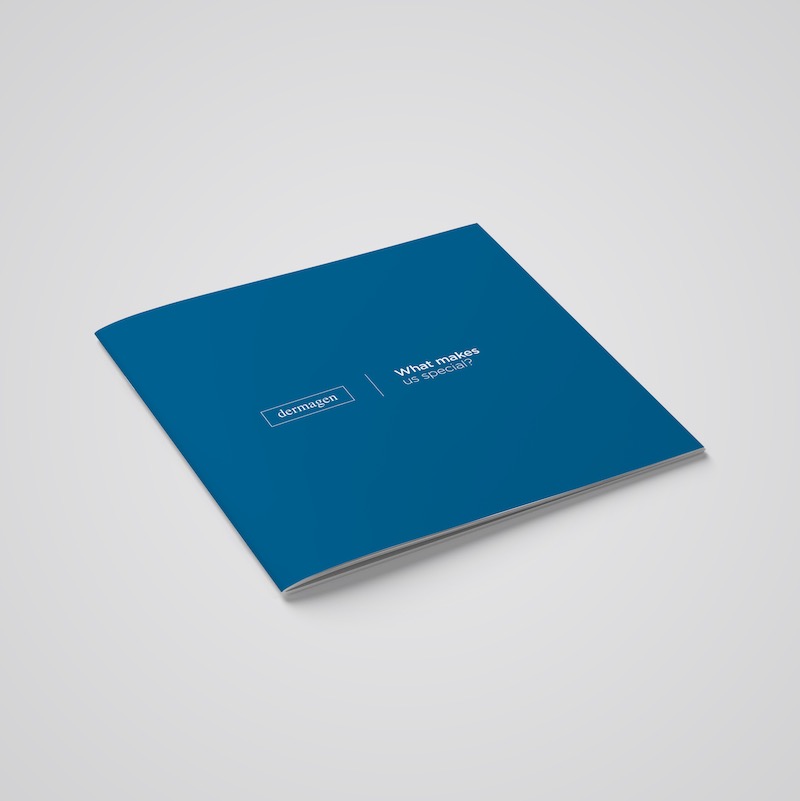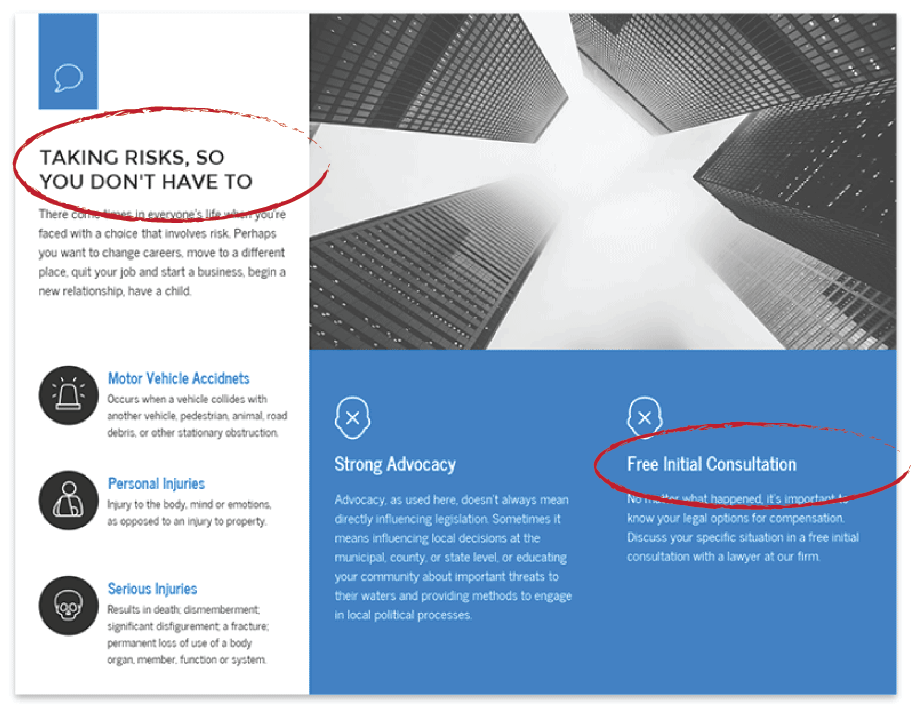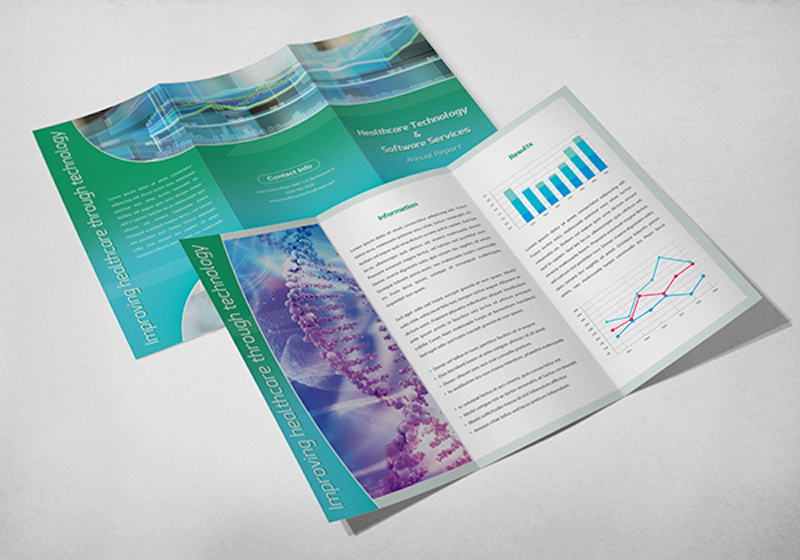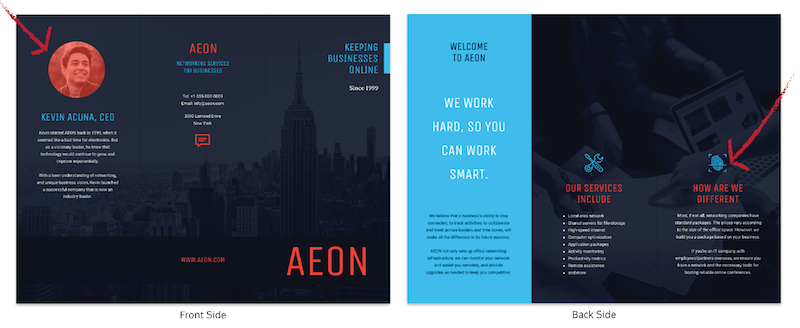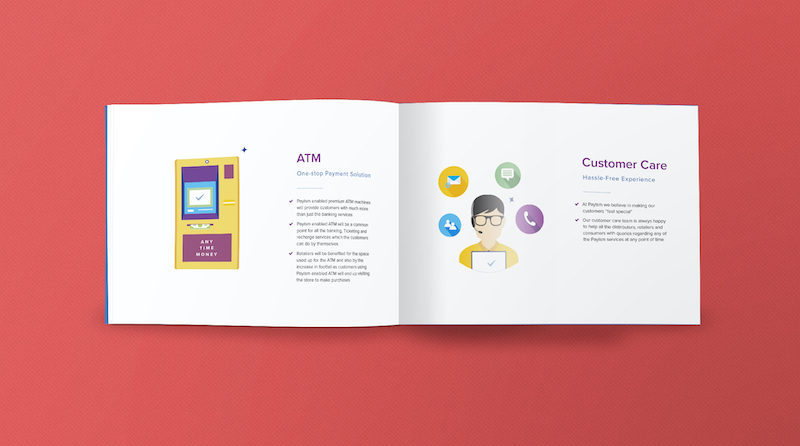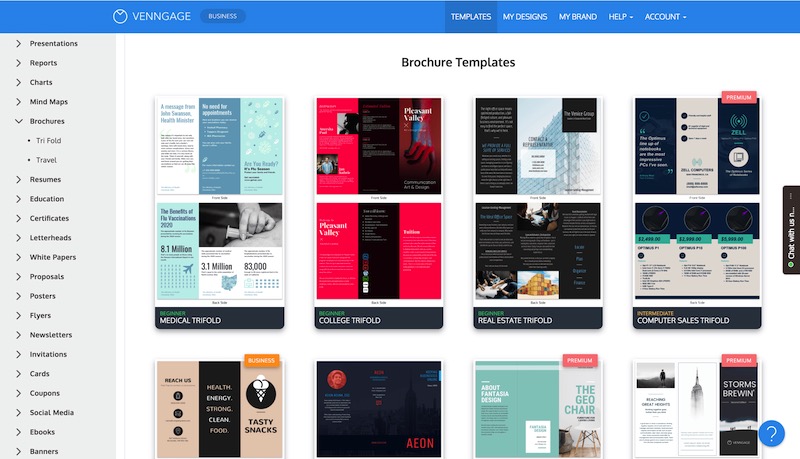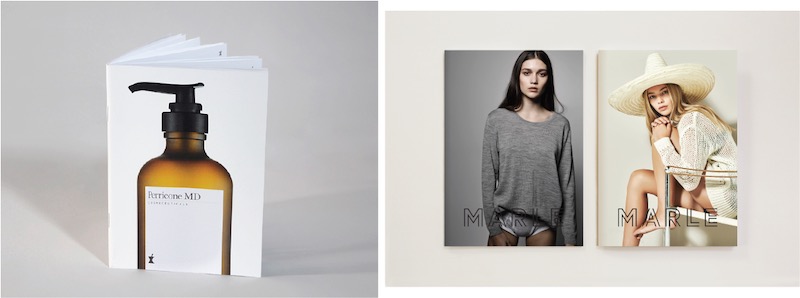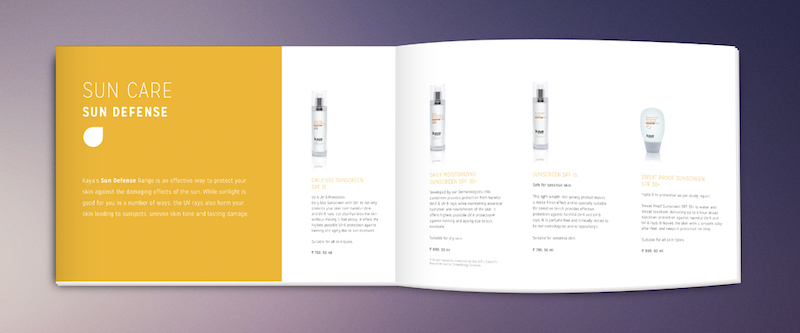What is a marketing brochure?
Marketing brochures help companies market their products or services. They’re traditionally single or multi-fold paper-based documents (although with the advent of the digital age, they also come in digital varieties as well) and come in various shapes and sizes (most often resembling a pamphlet or an A4 size piece of paper.)
Marketing brochures come in various fold types, namely: single fold brochures, bi-fold brochures (like the one below) and even tri-fold brochures and are used interchangeably with the term pamphlet.
What is the difference between a brochure and pamphlet?
A brochure can span multiple pages while pamphlets are often single-paged documents. Brochures are often created with a commercial intent in mind i.e. to promote your products or services while pamphlets are made with an informational intent.
Pamphlets are unbounded while brochures can span multiple pages and hence come binded.
Do you still need a marketing brochure?
The marketing brochure is one of the oldest tricks in the marketing playbook.
While digital strategies are dominating the modern marketing landscape, traditional techniques like the trusty sales brochure aren’t going anywhere.
In fact, physical marketing media may be more powerful than ever. One marketing research firm suggests that physical media is more memorable, more persuasive, and more likely to drive behavior than digital media.
The best marketing strategies of today integrate the digital with the physical, focusing on flyers, brochures, and posters just as much as websites and social media graphics.
That’s a lot to juggle!
I get it.
That’s why I’ve put together this easy 5-step marketing brochure design guide to give you the low-down on how to create a marketing brochure from scratch.
How to design a marketing brochure?
- Define the target audience for your marketing brochure
- Create thoughtful, targeted messaging for your marketing brochure design
- Collect unique, meaningful images or illustrations for your marketing brochure design
- Design the brochure around your copy, images, and branding
- Repurpose the same brochure design for different products
1. Define the target audience for your marketing brochure
Before you start thinking about what your brochure will look like, you need to figure out a few things about your customers and your goals.
Just like any other marketing material, a marketing brochure should be:
- Targeted to a specific segment of your market, and
- Aimed at driving some specific metrics.
Whether you segment your market by age, buying cycle, income, location, or lifestyle choices, your brochure’s messaging and imagery should be designed with a specific customer segment in mind.
A home insurance brochure targeting 75-85 year-old homeowners, for example, should look very different than one targeting 25-35 year old female renters:
 Sources: StockLayouts
Sources: StockLayouts
So your first step in developing a marketing brochure should always be to work out who you’re trying to target. If you think you might want to target more than one customer group, don’t worry! Our brochure templates make it a breeze to repurpose design again and again. Just focus on one target market to start.
Next, identify a single measurable metric that you want your brochure to boost. Ideally you should plan to use your brochure to compel potential customers to complete some specific action, like heading to your store or signing up for your email newsletter.
Figuring out what that action will be will help you write more persuasive and helpful copy. A few examples:
- You want to book more service consultations. Your brochure should highlight what clients will gain from the consultation and give them the contact information they’d need to book one.
- You want to push people to visit your booth at an upcoming trade show. Your brochure might showcase a new product you’ll have on hand at the show, and include a coupon for that product that’s redeemable during that event. Use our handy online coupon maker tool to generate them quickly.
- You want to drive people to check out your flashy new online store. Your brochure might feature a promo-code for first time visitors.
In any case, the key to creating a successful marketing brochure is to have a focus. Focus on the wants and needs of a specific segment of your market, and, if possible, on promoting a single action.
2. Create thoughtful, targeted messaging for your marketing brochure design
Once you have a clear focus mapped out, you’ll need to write some copy.
The structure of the brochure should guide this copywriting process. That is, you’ll need to figure out what belongs on the front, middle, and back of the brochure, and write accordingly:
Let’s review some strategies for each section in turn.
The front page should have a single clear message
The front page of your brochure needs to grab the attention of your reader. Everything on that page should compel them to turn the page.
That’s obviously easier said than done, but here are a few tried-and-true marketing tactics that might work for you.
Be clear about how you can fulfill your customers’ needs:
Build intrigue by proposing a question:
Keep it as brief and bold as possible:
If you’re promoting a product, let the product speak for itself:
If your brochure is just an informational summary of your business offerings, put your branding front and center (and include a tagline if you have one):
If you’re promoting a special deal, feature it on the front page:
Work in real estate? Check out our real estate brochures.
Different approaches will work better for different goals and businesses, so it’s up to you to choose the right one for you. Whichever tactic you choose, keep your copy succinct.
Limit yourself to one clear message on that front page, and express that message with as few words as possible.
A good rule of thumb? Make sure that front page copy comes in at under 25 words.
The main brochure contents should be concise and skimmable
Moving on from the front page, let’s talk about the main brochure contents.
Assuming you’ve succeeded in catching your readers’ attention, it’s time to give them what they really want–information about your products or services.
To do this, it’s best to write copy that will fit nicely into three sections, each with a header and brief description (a brochure with three sections is known as a tri-fold brochure):
Learn more about our travel brochure templates.
Use headers to state business offerings up front
Your headers should clearly and concisely state each business offering or product feature, so that readers can see at a glance what you’re promoting.
It’s important that these headings deliver meaning independently without requiring any further explanation. Try to avoid empty words like ‘introduction’ or ‘about’ in favour of more expressive descriptors:
If possible, frame these offerings based on your customers’ needs and wants. Focus less on what your business does, and more on how your business will give them what they want:
Use brief descriptions to backup your headers
Beneath each header, you’ll want to describe the product or service in more detail.
Keep these descriptions as brief and to-the-point as possible. Try to give your readers just enough information to get them interested, and let them use your brochure as a jumping-off point to get to your store or website.
Point form summaries are perfect:
If you use full sentences, limit yourself to two or three sentences per section.
Support your headers with charts and graphs when you can
Don’t waste space explaining data, statistics or survey results. Charts and graphs are easier to understand and more pleasing to the eye. They hit your point home and can also save space on your brochure.
For example, explaining that your company’s investment fund increased an average of 8% per year while your competitors were stuck at 4% or 6% may get lengthy. You can support brief headers and sections with a graph format on your brochure instead.
The back of the brochure design should include extra details like contact information
After you’ve outlined your offerings, make sure you include anything your customer will need to take action, whether it’s an email address to contact you at, directions to your business, or a link to your website.
This bit can come last–you’ve done your convincing, now you can count on your reader to flip to the back of the page to find this information on their own.
It’s standard practice to put the essential contact information in the middle:
That leaves one final section that needs some content. This is a good place to add extra information like pricing, but you can add whatever you like, as long as it includes a descriptive heading and isn’t too much longer than a paragraph. You could also include a QR code to engage your readers.
If you have doubts about your copywriting skills, consider an online copywriting service to get your marketing off on the right foot. Outsourcing copywriting can free up your time and let you focus on designing your content.
3. Collect unique, meaningful images or illustrations for your marketing brochure design
With your copy under control, it’s time to collect images to add visual interest to your brochure design.
To ensure your brochure doesn’t feel bare, aim to find:
- One image, icon, or illustration per product offering
- A feature image, icon, or illustration for your title page (optional)
- A few extra images, icons, or illustrations for your ‘about’ and ‘contact’ sections
In a perfect world, you’d have beautifully styled product shots around which to build your brochure:
But we don’t all have a marketing budget that stacks up against Nike’s.
If you don’t happen to have your own product shots, it might be tempting to use stock photos, but try your very best to avoid them!
Some better options? Add a personal touch by using your own headshot as a feature image, or use stylized icons:
Illustration-style images are a great way to add a playful touch:
If stock photos are your only option, do your best to find images that match your brand and fit a single color scheme for a cohesive look:
Prefer something simple? Our bi-fold brochure templates (a brochure with two sections) should do the trick.
Whether you choose icons, images, or illustrations, consistency is key! Inconsistency in image style and color can make your brochure design look unprofessional and will distract from the real hero – your product and your copy.
4. Design the brochure around your copy, images, and branding
It’s all come down to this–creating your marketing brochure.
At this point you should have copy and images to fill up all six sections of your brochure, front and back. Browse through our beautifully designed brochure templates for one that you like containing a similar amount of copy and visuals:
While it might be tempting to pick a template based on style, focusing instead on finding one that fits your content will make your life much easier (and you can change up the fonts and colors at the end).
Once you have one that you like, paste in your own copy, and swap out the stock photos for your own visuals.
If you’re happy with the design you can call it a day! Congratulations, you just made your first brochure.
But if your content doesn’t quite fit perfectly, or if you want to make your brochure design a little more personal, there are a few key tactics you can use to ensure you end up with something you can be proud of.
Center your content within each section
The easiest way to make text look good in a brochure is to center it horizontally within each of the six sections.
This keeps it away from the folds of the brochure, giving it some room to breathe!
If you center your text, center your icons and images too:
Size and crop images so they match
Make your image choices look deliberate by sizing them all to match. If possible, crop them to the same aspect ratio:
Or use a unique shape like a circle and size them equally:
And if they don’t crop nicely to exactly the same size, create a sense of consistency by lining them up nicely with your text:
Want something more unique and edgy?
Make it all about the image by pruning your text to the bare minimum. Leave a ton of white space, or extend your images to fill the entire page:
Sources: Monnet Design, Hannah Souter
Use solid colors and background images to define brochure sections
Once you have your text and images on your page, you might find your brochure design a little lacking in the excitement department. You can inject some visual interest by adding background colors and images.
Create definition between different sections by placing large images in the background of some sections and leaving others blank:
Or use a solid color in the background to brighten things up:
And add texture by adding image overlays on background images.
Dark overlays will help push images into into the background, while bright overlays can bring life to stock photos:
 Sources: Venngage, Hillary Jones
Sources: Venngage, Hillary Jones
Don’t use more than two or three colors
When it comes to brochure color schemes, less is more. My favourite brochure designs tend feature just one single bold color (occasionally more, but two or three colors at most).
How should you go about picking colors to use for your brochure?
This is where your brand colors can come in. If you have them, take cues from your logo or any other marketing materials like your website, business cards, flyers, and carry that styling into your brochure:
 Sources: Foodora, Petter Backlund
Sources: Foodora, Petter Backlund
Don’t have great brand colors to work with?
Fall back on the hot graphic design trends of the moment. Right now, that means bright colors and bold gradients:
Don’t have the design chops to pull off a trending color palette?
Pick a single bright color and run with it! A black and white brochure with a single-color accent is really easy to get right, and can be quite impactful:
Reds and blues are classic, but if you can, pull a highlight color from one of your images for a cohesive look:
Leave space in your brochure design
Last but certainly not least, leave lots of space in your brochure design. Don’t give in to the temptation to fill up your page with content. Leaving space for your content to breathe will really make that stuff shine:
Similarly, it’s easier to pull off a simple, minimalist design than a flashy one, so don’t hesitate to stick with a white background with black or grey text.
5. Repurpose the same brochure design for different products
Now that you’ve put all of this work into designing a beautiful brochure, get the most out of your design by creating subtle variations for different products.
Keep your layout the same, but swap out colors, images, and copy:
 Sources: Rebecca Finn, Gresham Design, Etienne Axelos
Sources: Rebecca Finn, Gresham Design, Etienne Axelos
Conclusion
This might seem like a long process, but knowing how to put together an effective marketing brochure is an essential skill for any small business owner or marketer, and our pre-designed brochure templates make it easy!
Follow these 5 simple steps create your own marketing brochure:
1. Define the target market for your marketing brochure
2. Write copy that speaks to your target market
- Give your front page a single clear message
- Make main brochure contents should concise and skimmable (3 sections, descriptive headers, point-form)
- Include include extra details like contact information on the back
3. Use images, icons, and illustration to support your messaging.
- Keep style and color scheme consistent
4. Layout the brochure around your copy, images, and branding
- Center your content within each section
- Size and crop images consistently
- Use solid colors and background images to define brochure sections
- Don’t use more than two or three colors
- Leave lots of white space
5. Play with color and content to repurpose the same brochure design for different products

































